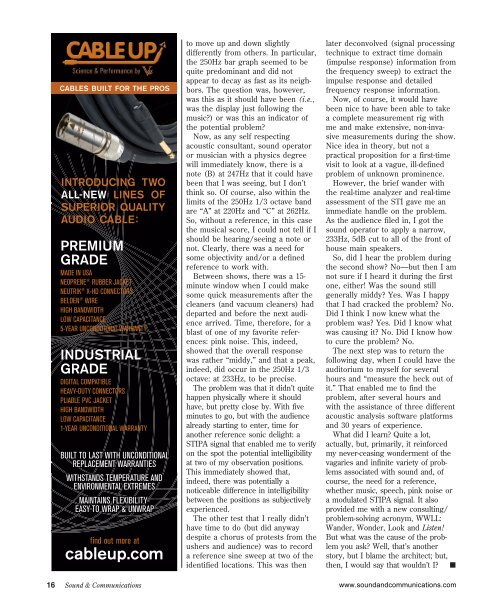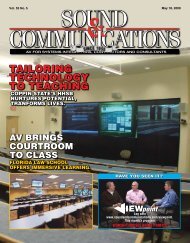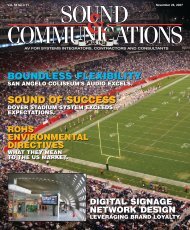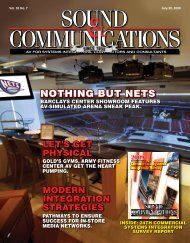Sound and Communications - February 2008 Issue
Sound and Communications - February 2008 Issue
Sound and Communications - February 2008 Issue
You also want an ePaper? Increase the reach of your titles
YUMPU automatically turns print PDFs into web optimized ePapers that Google loves.
CABLES BUILT FOR THE PROS<br />
INTRODUCING TWO<br />
ALL-NEW LINES OF<br />
SUPERIOR QUALITY<br />
AUDIO CABLE:<br />
PREMIUM<br />
GRADE<br />
MADE IN USA<br />
NEOPRENE ® RUBBER JACKET<br />
NEUTRIK ® X-HD CONNECTORS<br />
BELDEN ® WIRE<br />
HIGH BANDWIDTH<br />
LOW CAPACITANCE<br />
5-YEAR UNCONDITIONAL WARRANTY<br />
INDUSTRIAL<br />
GRADE<br />
DIGITAL COMPATIBLE<br />
HEAVY-DUTY CONNECTORS<br />
PLIABLE PVC JACKET<br />
HIGH BANDWIDTH<br />
LOW CAPACITANCE<br />
1-YEAR UNCONDITIONAL WARRANTY<br />
BUILT TO LAST WITH UNCONDITIONAL<br />
REPLACEMENT WARRANTIES<br />
WITHSTANDS TEMPERATURE AND<br />
ENVIRONMENTAL EXTREMES<br />
MAINTAINS FLEXIBILITY-<br />
EASY TO WRAP & UNWRAP<br />
find out more at<br />
cableup.com<br />
to move up <strong>and</strong> down slightly<br />
differently from others. In particular,<br />
the 250Hz bar graph seemed to be<br />
quite predominant <strong>and</strong> did not<br />
appear to decay as fast as its neighbors.<br />
The question was, however,<br />
was this as it should have been (i.e.,<br />
was the display just following the<br />
music?) or was this an indicator of<br />
the potential problem?<br />
Now, as any self respecting<br />
acoustic consultant, sound operator<br />
or musician with a physics degree<br />
will immediately know, there is a<br />
note (B) at 247Hz that it could have<br />
been that I was seeing, but I don’t<br />
think so. Of course, also within the<br />
limits of the 250Hz 1/3 octave b<strong>and</strong><br />
are “A” at 220Hz <strong>and</strong> “C” at 262Hz.<br />
So, without a reference, in this case<br />
the musical score, I could not tell if I<br />
should be hearing/seeing a note or<br />
not. Clearly, there was a need for<br />
some objectivity <strong>and</strong>/or a defined<br />
reference to work with.<br />
Between shows, there was a 15-<br />
minute window when I could make<br />
some quick measurements after the<br />
cleaners (<strong>and</strong> vacuum cleaners) had<br />
departed <strong>and</strong> before the next audience<br />
arrived. Time, therefore, for a<br />
blast of one of my favorite references:<br />
pink noise. This, indeed,<br />
showed that the overall response<br />
was rather “middy,” <strong>and</strong> that a peak,<br />
indeed, did occur in the 250Hz 1/3<br />
octave: at 233Hz, to be precise.<br />
The problem was that it didn’t quite<br />
happen physically where it should<br />
have, but pretty close by. With five<br />
minutes to go, but with the audience<br />
already starting to enter, time for<br />
another reference sonic delight: a<br />
STIPA signal that enabled me to verify<br />
on the spot the potential intelligibility<br />
at two of my observation positions.<br />
This immediately showed that,<br />
indeed, there was potentially a<br />
noticeable difference in intelligibility<br />
between the positions as subjectively<br />
experienced.<br />
The other test that I really didn’t<br />
have time to do (but did anyway<br />
despite a chorus of protests from the<br />
ushers <strong>and</strong> audience) was to record<br />
a reference sine sweep at two of the<br />
identified locations. This was then<br />
later deconvolved (signal processing<br />
technique to extract time domain<br />
(impulse response) information from<br />
the frequency sweep) to extract the<br />
impulse response <strong>and</strong> detailed<br />
frequency response information.<br />
Now, of course, it would have<br />
been nice to have been able to take<br />
a complete measurement rig with<br />
me <strong>and</strong> make extensive, non-invasive<br />
measurements during the show.<br />
Nice idea in theory, but not a<br />
practical proposition for a first-time<br />
visit to look at a vague, ill-defined<br />
problem of unknown prominence.<br />
However, the brief w<strong>and</strong>er with<br />
the real-time analyzer <strong>and</strong> real-time<br />
assessment of the STI gave me an<br />
immediate h<strong>and</strong>le on the problem.<br />
As the audience filed in, I got the<br />
sound operator to apply a narrow,<br />
233Hz, 5dB cut to all of the front of<br />
house main speakers.<br />
So, did I hear the problem during<br />
the second show? No—but then I am<br />
not sure if I heard it during the first<br />
one, either! Was the sound still<br />
generally middy? Yes. Was I happy<br />
that I had cracked the problem? No.<br />
Did I think I now knew what the<br />
problem was? Yes. Did I know what<br />
was causing it? No. Did I know how<br />
to cure the problem? No.<br />
The next step was to return the<br />
following day, when I could have the<br />
auditorium to myself for several<br />
hours <strong>and</strong> “measure the heck out of<br />
it.” That enabled me to find the<br />
problem, after several hours <strong>and</strong><br />
with the assistance of three different<br />
acoustic analysis software platforms<br />
<strong>and</strong> 30 years of experience.<br />
What did I learn? Quite a lot,<br />
actually, but, primarily, it reinforced<br />
my never-ceasing wonderment of the<br />
vagaries <strong>and</strong> infinite variety of problems<br />
associated with sound <strong>and</strong>, of<br />
course, the need for a reference,<br />
whether music, speech, pink noise or<br />
a modulated STIPA signal. It also<br />
provided me with a new consulting/<br />
problem-solving acronym, WWLL:<br />
W<strong>and</strong>er, Wonder, Look <strong>and</strong> Listen!<br />
But what was the cause of the problem<br />
you ask? Well, that’s another<br />
story, but I blame the architect; but,<br />
then, I would say that wouldn’t I? ■<br />
16 <strong>Sound</strong> & <strong>Communications</strong><br />
www.sound<strong>and</strong>communications.com
















